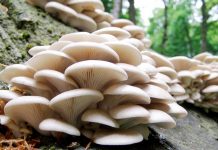
There is growing interest in developing commercial cultivation of mushrooms throughout Africa. The uptake of mushroom cultivation has been more noticeable in urban areas.
What are mushrooms?
Cultivated mushrooms are edible fungi that grow on decaying organic matter, known as a substrate. Unlike vegetables they do not rely on sunlight to grow. Mushrooms start as very small spawns. The spawns will grow in the substrate to produce a fine white fibrous structure called mycelium. From the mycelium the mushroom fruit is produced. This is the part that is harvested.
Mushrooms have a high nutritional value and are high in protein. They are also a good source of vitamins (B1, B2, B12 and C), essential amino acids, and carbohydrates but are low in fat and fibre and contain no starch. When fresh they have a very high water content of around 90%. Minerals present include phosphorus, potassium, iron and copper.
Mushrooms grow in bursts known as flushes approximately every 7 to 10 days for a few weeks with yields falling over time. The first three flushes yield more than 70% of the total. The growing time will be dependant on type of mushroom and the growing conditions.
Mushrooms for cultivation
There are two main types of edible mushroom grown – the white button mushroom (Agaricus Bisporus) and to a lesser extent oyster mushrooms (Pleurotus ostreatus). Other species have also been successfully cultivated, including wild Reishi mushroom (Ganoderma lucida). Under average conditions 50 to 70kg of Pleurotus strain of mushroom can be produced from 100kg of substrate, over a period of a few weeks, and with optimal conditions the yielded can rise to a 100kg.
There has been a great amount of research into mushrooms and their cultivation in temperate climates but relatively little on varieties suitable for tropical climates although interest in this area is growing. Many commercial mushrooms only fruit at around 20°C and are therefore not suitable for tropical regions. Suitable tropical stains are harder to obtain but some commercial strains can be ordered such as strains of Agaricus bitorquis that fruit at 28°C.
What to grow your mushrooms in – Substrates
Mushrooms can be cultivated on a wide variety of substrate. The quality of the substrate is the main factor in the success of growing mushrooms as it provides all the energy and nutrients that the mushrooms will use while growing. Different strains of mushroom will require different substrate mixes. The substrate must not be rotten, mouldy and should be kept dry while in storage.
Agricultural wastes are often used as a source of material for the substrate including; cassava stalks, cocoa pods, coffee bean husks, coffee pulp, corn cobs, corn stubble, cotton seed cake, pulse husks, rice hulls, sawdust, sugarcane bagasse, tealeaves, tobacco stalks, wheat straw and water hyacinth.
Preparation process
A suitable area needs to be set aside for preparing the substrate. For best results it should consist of a large concrete floor which has a slope, so that run-off can be collected and reused. A storage area is needed for the straw, chicken manure etc used to make the substrate, but the longer any manure is stored the more nitrogen will be lost. Another smaller area is required for filling the substrate into its growing bags or trays. This is usually roofed and walled. Lime, gypsum, small tools and chemicals for pest and disease control should be stored separately is a secure area.
The preparation to make a substrate for Pleurotus involves mixing with water. This can be done by Spraying the heap of material with a hose Making a flat pile and using a sprinkler Soaking in a tank of water.
Soaking requires a suitable container for mixing the water and the substrate materials together to allow the straw etc to soak up water. Alternatively a pit can be dug. The size of the container will depend on the scale of production. For small scale operation 100 to 200 litres capacity is suitable. It needs to be 60cm deep. If it is not watertight then a liner of thick plastic can be used. A cover is used to help submerge the substrate material that would otherwise float in the water. The cover may need to be weighted down.
Blocks of substrate can be made more easily from material (straw etc) that has been cut into uniform pieces before being submerged. Other materials may not need pre treatment.
The substrate is submerged in water for 10 days, during which time it partially ferments and any insects in the material are killed. During this time the substrate absorbs the water so the level of water needs to be checked. If the substrate is no longer submerged then more water needs to be added along with an appropriate amount of fungicide. The fermentation will take place between 8 to 28°C. After this period the excess water can be drained off. The resulting material may initially smell sour.
The substrate can then be stored in strong plastic bags of around 30 to 40cm diameter which will hold around 20 to 30kg of material.



